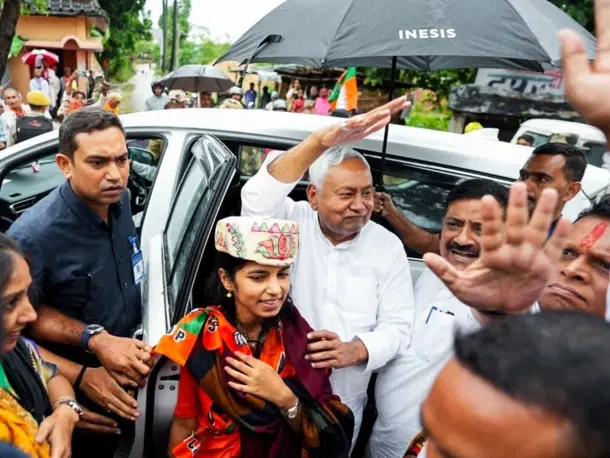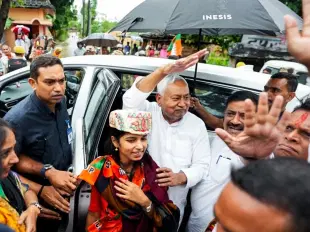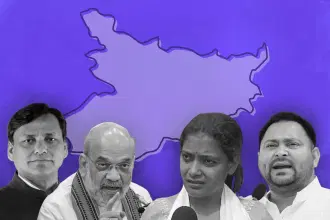Bihar
What Does Bihar Look Like In 2025? Reflections And Anticipations..
Venu Gopal Narayanan
Nov 05, 2025, 09:52 AM | Updated 10:11 AM IST
Save & read from anywhere!
Bookmark stories for easy access on any device or the Swarajya app.


As Bihar enters the final stage of a gruelling campaign for its legislative assembly polls this week, the general consensus is that the outcome is too close to call. Nonetheless, it is worth trying to assess qualitatively which way the wind might be blowing.
On one side stands Chief Minister Nitish Kumar of the Janata Dal (United), or JD(U), who has enjoyed a near-uninterrupted run in that post for two decades. That is the only constant in a state where Nitish Kumar has switched allies so many times that it is difficult to keep count.
For the past few years, his principal ally has been the Bharatiya Janata Party (BJP), supported by Chirag Paswan’s Lok Janshakti Party (LJP), with whom Nitish Kumar’s ties are strained to say the least. Despite that, this National Democratic Alliance (NDA) coalition has performed fairly well in government and in the Lok Sabha elections of June 2024.
The problem is that the BJP has not been able to grow in the state as it should have, because every flip by Nitish Kumar has required damage control followed by a return to the drawing board. As a result, there is the strange spectacle of the BJP playing senior partner during Lok Sabha elections and either second fiddle or the opposition in assembly elections.
Even so, these constant flip-flops have taken their toll. In 2019, the NDA won 39 of 40 Lok Sabha seats with a thumping 53 per cent vote share. However, in 2024, after suffering Nitish Kumar’s capriciousness in between, the NDA lost eight seats, six per cent of the popular vote, and, for good measure, the BJP endured the ignominy of losing the Arrah seat to the very same Maoists whom it is determined to quell nationally by 2026.
The bulk of this vote swing went directly to the principal opposition party, the Rashtriya Janata Dal (RJD), led by Tejaswi Yadav, son of Laloo Yadav. Their ally, the Congress party, did not benefit much from this swing because it has ceased to exist in the state for all practical purposes since the 1980s. The Congress might rebut this by pointing out that it has consistently won Kishanganj since 2009, but that is only because it is a Muslim-dominated seat.
The Maoists, on the other hand, have benefited significantly from both their alliance with the RJD and the electoral fallout of Nitish Kumar’s periodic U-turns. In the 2020 assembly elections, they won 12 seats, and in the 2024 general elections, they won two parliamentary seats – Arrah and Karakat.
This means that the RJD’s vote bank, composed mainly of Muslims and Yadavs, remains intact. It also means that the RJD and its allies would benefit handsomely from even a slight dissatisfaction with the NDA. To add to that, in 2024, the NDA lost more than five per cent of its vote share in 22 of 40 seats. Eleven of these 22 seats were contested by the BJP, and to its credit, it managed to win eight of them (all holds).
Interestingly, Paswan’s LJP does not feature on this list of 22 seats. While that is good for the NDA, it also means that the BJP’s growth in Bihar remains stunted, particularly among Dalits, whom the LJP represents.
Added to this is the fact that Nitish Kumar is visibly ageing, with no clear successor for the JD(U) in sight, and the challenges before the BJP continue to mount.
Under these confusing and contradictory circumstances, is it any wonder that Bihar remains largely untouched by modernisation, industrialisation, or progress?
Tejaswi Yadav may not yet have reached the stature of his father, but he has certainly demonstrated in recent years that he can rouse his troops and carry the battle to the enemy with flair. He might not have a message beyond the usual identity politics and extravagant promises, such as a government job for every family, nor a plan for the development of Bihar, but he is no pushover, and neither is the RJD. Such reckless competitive welfarism resonates strongly in a dirt-poor state like Bihar.
Consider the situation: so far, Bihar has missed the mechanised agriculture boom of this century, as seen in states like Gujarat, Rajasthan, and Madhya Pradesh. It has missed the IT boom. It has missed the pharmaceutical boom, the services boom, and the manufacturing boom. Instead, it sits in a strange space between a semi-remittance economy and quasi-subsistence agriculture, where urbanisation has barely touched double digits.
From a developmental perspective, this presents a significant opportunity, primarily because investments in Bihar would be extremely cost-competitive when compared with states that have already matured economically, such as the Big Four: Gujarat, Maharashtra, Karnataka, and Tamil Nadu. Unfortunately, the gap between theory and practice will be defined by the next five years, whose direction will be decided by a disenchanted electorate this month.
Having said that, Prime Minister Narendra Modi is currently conducting an energetic electoral campaign across the state. Reflecting that, the seat-sharing agreement among NDA allies was concluded amicably, with hardly any fuss. Moreover, word on the street is that the Sangh and its diverse affiliates are conducting an intensive grassroots door-to-door outreach programme. In addition, pollster-turned-politician Prashant Kishor’s decision not to contest these assembly elections means that any vote leakage from the NDA will be far less than previously anticipated.
Taken together, this suggests a slender advantage for the NDA, with a reasonable possibility that it may indeed secure the popular mandate in Bihar.
Venu Gopal Narayanan is an independent upstream petroleum consultant who focuses on energy, geopolitics, current affairs and electoral arithmetic. He tweets at @ideorogue.




